Phobos |
Phobos, satellite of Mars | |  Automatic translation Automatic translation | | Updated June 01, 2013 |
The two moons of Mars are Phobos and Deimos. These moons of Mars may well be captured asteroids from the main asteroid belt located between Mars and Jupiter.
These two satellites orbiting close to their planet, a few thousand miles of it, 9,377 km for Phobos and Deimos 23,460 km. The diameter of Mars is only 6,792 km. Both moons are linked to Mars by the tidal forces and therefore always show the same face to their planet, as does the moon relative to Earth. Because Phobos orbits Mars in 7:39, faster than the planet Mars turns on itself (24H36), the tidal forces are decreasing its orbital radius of a slow but steady pace of a few centimeters per year.
Since its orbit is below synchronous altitude in 20 to 40 million years, it is possible that Phobos crashes or crashes on the Martian surface. | | NB: The names of its moons are an allusion to a Greek verse, "The God of War arrives, flanked by two satellites (thugs) fear and terror" phobos is Greek for 'fear' and Deimos 'terror'. Image: Phobos is a highly irregular measure 27 × 21.6 × 18.8 km, it is also one of the smallest moons in the solar system.
You can see the crater Stickney feature in the bottom right of the photograph.| Phobos | Characteristic | | dimensions | 27×21×18 km | | density | 1,85×103 kg/m³ | | gravity | 0,005 m/s² | | Semi-major axis | 9 377,1 km |
| | 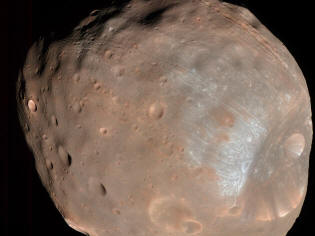 |
Crater Stickney on Phobos | | | | |
Phobos, the larger (27 × 21 × 18 km) of the two moons of Mars is made of icy rocks, rich in carbon. Phobos is peppered with impact craters like all terrestrial objects in the solar system. The crater Stickney of 9 km in diameter, is the largest crater on the Martian moon, it is almost half the diameter of Phobos. The crater was so named in honor of Chloe Angeline Stickney Hall, mathematician and astronomer, wife of Asaph Hall, who discovered the two moons of Mars August 12, 1877.
Despite the low gravity (0.005 m / s ²) of Phobos, one can guess that the material of the meteorite that struck Phobos, slid slowly slopes of the crater walls. The paths that lie on the surface of Phobos, are less than 30 m deep, 100-200 m wide and up to 20 km long. | | Image: Stickney Crater is over 9 km in diameter (about half the diameter of Phobos), Stickney. It is so great that the meteorite could have completely disintegrated the small moon of Mars.
This beautiful image of Stickney and the surrounding area, was taken by the HiRISE camera of the Mars Reconnaissance Orbiter 6000 km from Phobos.NB: if we imagine on the surface of Phobos, Mars is 6400 times greater than the full Moon seen from Earth, which represents one quarter of the celestial hemisphere of Phobos. | | 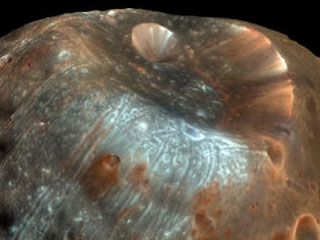 |
Phobos and Deimos | | | | |
The names of the two moons of Mars are derived from Greek mythology, Phobos (Fear) and Deimos (terror), the twins that the god Ares had with the goddess Aphrodite. Deimos is covered with a thick layer of particles ejected during the impacts of meteorites, which blurs its relief by filling craters gradually. There is no such feature on Phobos is closer to Mars, where dust is influenced by tidal forces of Mars.
These two satellites could come from the asteroid belt, which passed near the planet Mars have been captured. Deimos is at a distance of 23,460 km of Mars and Phobos at 9377 km.
The gravity at the surface of Deimos is very low (0.0039 m/s-2). Its density is only 2.2 g/cm3. Its escape velocity is 22 km/hour or 6 m / s), which would allow a man to leave the soil of Deimos simply by running. | | Phobos is the larger of the two moons of Mars.
It is also the closest, it orbits around the red planet in 7 hours and 39 minutes.
At the time of the shooting, she was 11,800 miles of Mars Express, while Deimos was 26 200 km. Image: This unique picture of the Martian moons Phobos and Deimos whole, was captured by Mars Express November 5, 2009 by the HRSC instrument (High Resolution Stereo Camera).
Here, Deimos is more than twice as far from the camera than Phobos. | | 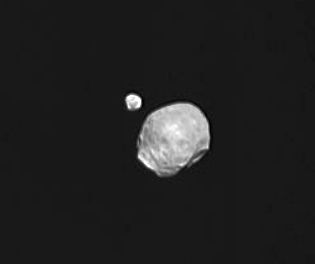 |
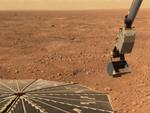
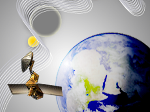
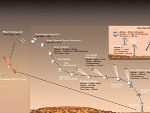
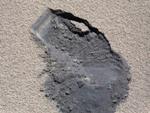
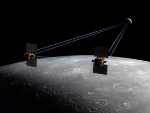

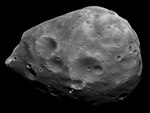
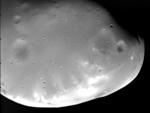
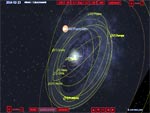


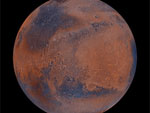



 Automatic translation
Automatic translation

